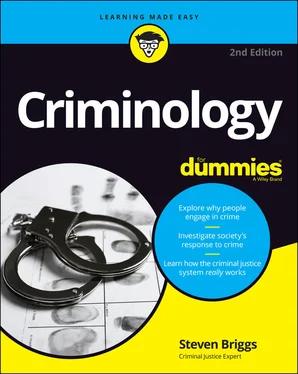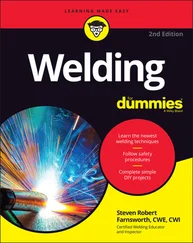Significantly, within the last ten years, a movement to grant rights to victims has gathered tremendous momentum. In most states today, victims have at least the following rights:
The right to be notified of all important hearings
The right to speak at release hearings where criminal defendants seek to be released from jail
The right to obtain a “no contact” order, which prohibits the defendant from contacting the victim
The right to prevent the defendant from getting the victim’s address
The right to demand a blood test of the defendant if there’s a possibility that a disease, such as HIV or hepatitis, was transferred to the victim during the crime
The right to receive restitution for financial impact from a crime
The right to give a statement to the judge explaining the impact of the crime on the victim at the time of sentencing the defendant
For much more information about what the criminal justice system does to protect victims, see Chapter 4.
Considering Categories of Crime
Law enforcement professionals often group crimes into the following two categories:
Violent crimes (also called person crimes )
Property crimes
But a careful study of crime reveals that organized crime, in which groups engage in a business of crime, is a whole different animal worthy of separate analysis.
Studying individual crimes
When police respond to a 9-1-1 call, they’re almost always responding to an individual crime. Someone was assaulted or burglarized, for example. Typically, police treat violent crimes much more seriously than they do property crimes. For example, although a murder investigation may have ten or more cops assigned to it, police may not even respond in person to investigate a burglary at a home. Obviously, this discrepancy occurs because protecting personal safety is the number one job of people in law enforcement; plus, police resources are finite.
Here are the crimes you most likely think of when you consider individual crimes:
| Violent Crimes |
Property Crimes |
| Murder and manslaughter |
Theft (including shoplifting, embezzlement, Internet fraud, identity theft, and car theft) |
| Assault and battery (including domestic abuse, child abuse, and vehicular assault) |
Burglary |
| Sexual crimes (rape, sodomy, and child molestation) |
Arson |
| Robbery |
|
Obviously, the punishment for violent crime is much more severe than it is for property crime. A person who shoplifts from a convenience store (a property crime) will get a much lighter sentence than someone who sticks a gun in the store clerk’s face and demands cash (the violent crime of robbery).
Among different violent offenses, the punishment can vary depending on whether a weapon was used, how much harm was caused, and whether the “bad guy” intended to cause harm. For example, a drunk driver who crashes and kills his passenger will receive a much shorter prison sentence than a woman who knowingly poisons her mother-in-law. The drunk driver didn’t intend to kill anyone, but the evil daughter-in-law surely did. (For more info, check out Chapter 5on violent crimes and Chapter 6on property crimes.)
Focusing on organized crime
Despite what you see on TV, organized crime is much more than the Italian mob. In fact, the mafia is really only a very small part of the organized crime threat in the United States today. Organized crime refers to the groups of individuals who organize themselves in a hierarchical structure, usually for the purpose of engaging in the business of crime. These groups are set up in such a way that even when police arrest one or two members, the organization continues to operate. This structure is what makes fighting organized crime so difficult.
Organized crime groups are traditionally set up along ethnic lines, in large part, because members of the same ethnic group are more likely to know and trust one another. (However, a group called the United Nations gang, known for its ethnic diversity, was taken down in May 2009 for a large-scale drug-smuggling operation between Canada and the United States.)
Some common organized crime groups include the following:
Motorcycle gangs
Drug-smuggling operations
Prison gangs
Street gangs
White-supremacist organizations
These groups usually gravitate toward the types of criminal activities that provide the most income. Obviously, much of this activity includes illegal drugs. But it also includes tobacco smuggling, trafficking in counterfeit goods, and Internet fraud. Plus, you can’t forget the more traditional, localized organized crime activities, such as extortion, loan sharking, and robbery. And some groups, like white-supremacist criminal organizations, aren’t as interested in making money; they’re actually closer to being terrorist organizations. In Chapter 8, I go into much greater detail about the organized crime threat and how law enforcement is dealing with it.
Throughout the world, and here in the United States, organized groups are using violence and the threat of violence to achieve political and social goals. These groups are called terrorists, and, today, criminal justice professionals are on the front lines in the fight against terrorism. Most known terrorist plots in the United States have been first identified or foiled by local police. As a result, it’s standard practice for cops throughout the country to be trained in identifying signs of terrorist activity.
Terrorism experts generally categorize the terrorist threat into two groups: right-wing and left-wing. But, in reality, hundreds of international groups have many different agendas, and numerous domestic terrorist groups tout principles ranging from animal rights to white supremacy, that do not fit on a political spectrum.
While law enforcement tends to investigate terrorists using the same methods used to attack organized crime, a significant threat continues to be the “lone wolf” actor, who goes at it alone. Omar Maten killed 49 people and wounded 50 more when he entered an Orlando nightclub in 2016 and, in the name of the Islamic State, unloaded on the guests with two semi-automatic weapons. Such lone wolf attacks are very challenging to detect because the attackers don’t communicate their plans to accomplices.
In Chapter 10, I discuss the major terrorist threats that the United States faces today.
Figuring Out What Makes Someone Commit a Crime
One significant branch of criminology focuses on determining the causes of crime. Why do some people become life-long criminals while others become productive members of society? If criminologists — or anyone for that matter — can answer this question, maybe they can figure out some ways to prevent crime.
The following sections just skim the surface of the major theories criminologists have developed for why people commit crime. For a much more detailed discussion of the various causes of crime, check out Chapters 12through 15.
Making a rational decision
Underlying society’s current response to crime is the rational choice theory, which says that people generally make rational decisions about choices in their lives, including decisions to commit crime. This theory holds that when deciding whether to commit an illegal act, a person assesses the potential rewards and risks and then acts accordingly. If society provides enough punishment, a rational actor will decide not to commit crime. Thus, the threat of punishment acts as a deterrent to committing crime.
Читать дальше












